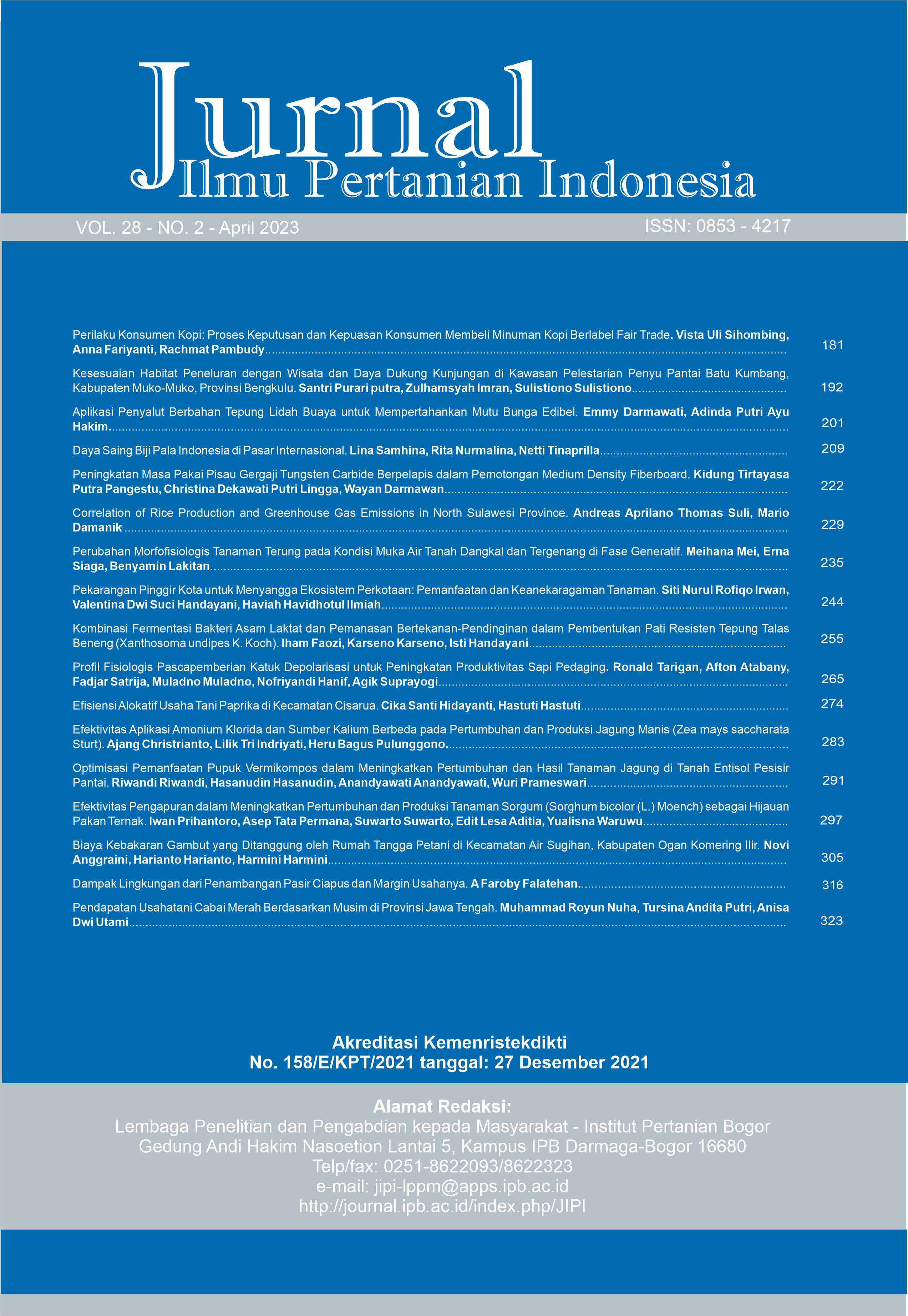Optimisasi Pemanfaatan Pupuk Vermikompos dalam Meningkatkan Pertumbuhan dan Hasil Tanaman Jagung di Tanah Entisol Pesisir Pantai
Abstract
Entisol has poor physical, chemical, and biological properties that limit the growth and yield of maize. This study aimed to obtain the correct dose of vermicompost to increase the growth and yield of maize on Entisols. The research was arranged using Randomized Block Design, consisted of 7 treatment doses of vermicompost fertilizer (0; 2.5; 5; 7.5; 10; 12.5; and 15 Mg ha-1 and 4 re;plications. The results showed that the dose of vermicompost significantly affected the growth and yield of maize in coastal entisol soils. The dose of 10 Mg ha-1 was the best on plant height, leaf number, fresh weight, plant dry weight, shoot fresh weight, fresh root weight, and shoot and root dry weight. Meanwhile, the dose of 12.5 Mg ha-1 produced the best maize yields for the fresh weight of husked ear per plant, fresh weight of unhusked ear per plant, and dry grain weight per plant, namely, 322.75 g, 286.66 g, and 173.4 g, respectively. The best results of fresh weight of husked ear per plot, fresh weight of unhusked ear per plot, and dry grain weight per plot were achieved by vermicomposting of 15 Mg ha-1, which were 11.28 kg, 9.72 kg, and 5.94 kg, respectively.
Keywords: coastal, Entisol, maize, vermicompost, yield
Downloads
References
Akintoye HA, Olaniyan AB. 2012. Yield of sweet corn response to fertilizer sources. Global Advanced Research Journal of Agricultural Science. 1(5): 110116.
Atarzadeh SH, Mojaddam M, Saki NT. 2013. The interactive effects humic acid application and several of nitrogen fertilizer on remobilization star wheat. International Journal of Biosciences. 3(8): 116123.https://doi.org/10.12692/ijb/3.8.116-123
Allen J. 2016. Vermicomposting. Guide H-164 (Revised). Cooperative Extention Service. College of Agricultural, Consumer and Environmental Sciences. NM State University. Original author: George W. Dickerson, Extension Horticulture Specialist.
Fahrurrozi ZM, Dwatmadji N, Setyowati S, Sudjatmiko, Chozin M. 2016. Growth and yield responses of three sweet corn (Zea mays L. Var. Saccharata) varieties to local based organic fertilizer. International Journal on Advanced Science, Engineering and Information Technology. 6(3): 319323.https://doi.org/10.18517/ ijaseit.6.3.730
Kannan RL, Dhivya M, Abinaya D, Krishna RL, Krishnakumar S. 2013. Effect of integrated nutrient management on soil fertility and productivity in maize. Bulletin of Environment, Pharmcology, and Life Sciences 2(8):6167.
Manish KP, Prakash M, Salikram G. 2017. Growth Attributing Traits of Maize Affected by Different Nutrient Management in Lamjung Nepal. Internatonal Journal of Applied Sciences and Biotechnology. 5(1):986101 .https://doi.org/10.3126/ijasbt.v5i1. 17026
Masri IN, Abu Bakar NH, Yusoff WAW, Basir MH. 2016. Penghasilan vermikompos menggunakan bahan sisa buangan pertanian (The production of vermicompost from agricultural waste).Buletin Teknologi MARDI, Bil. 10(2016): 29–35.
Meade G, Lalor STJ, Mc.Cabe T. 2011. An Evaluation of the combined usage of separated liquid pig manure and inorganic fertilizer in nutrient programmes for winter wheat production. European Journal of Agronomy. 34(2): 6270.https://doi.org/10.1016/ j.eja.2010.10.005
Mihiretu S. 2014. Effect of application of lime (CaCO3) and phosphorus on yield and yield components of maize (Zea mays L.) on Nitisols at Wolaita Sodo, Southern Ethiopia. [Tesis]. Haramaya (ET): Haramaya University.
Oluwatoyinbo FI, Akande MO, Adediran JA. 2005. Response of okra (Abelmoschus esculentus) to lime and phosphorous fertilization in an acid soil. World Journal of Agricultural Sciences 1:178183.
Pemerintah Provinsi Bengkulu. 2015. Geologi Pemerintah Provinsi Bengkulu. [internet]. Diakses pada tanggal Juni 2022. Tersedia pada: http://bengkuluprov.go.id/.
Rahmawati E, Herumurti W. 2016. Vermikompos sampah kebun dengan menggunakan cacing tanah Eudrilus eugeneae dan Eisenia fetida. Jurnal Teknik. 5(1): C33C37. https://doi.org/10.12962/ j23373539.v5i1.11292
Reza S, Pal S, Singh S. 2012. Rock phosphate-enriched pressmud compost: Direct effect in pearl millet(Pennisetum glaucum L.) and residual effect in mustard (Brassica juncea) in a typic haplustept.Journal Indian Society of Soil Science. 60: 138–144.
Riwandi, Hasanudin, Gusmara H, Anandyawati. 2020. Soil quality engineering using vermicompost and its effect on the corn (Zea mays L.) production in coastal area. Journal of Tropical Soils. 25(3):127135.https://doi.org/10.5400/jts.2020.v25i3.127-135
Riwandi, Hasanudin, Gusmara H, Anandyawati. 2019. Rekayasa kualitas tanah dengan vermikompos dan aplikasinya terhadap tanaman jagung di lahan pesisir. Laporan Penelitian Unggulan Universitas Bengkulu. Bengkulu (ID).
Setiawati MR, Sofyan ET, Nurbaity A, Suryatmana P, Marihot GP. 2017. Pengaruh aplikasi pupuk hayati, vermikompos dan pupuk anorganik terhadap kandungan N, populasi Azotobacter sp. dan hasil kedelai edamame (Glycine max (L.) Merill) pada inseptisol Jatinangor. Agrologia. 6(1): 110.https:/ /doi.org/10.30598/a.v6i1.174
Zaremanesh H, Nasiri B, Amiri A. 2017. The effect of vermicompost biological fertilizer on corn yield. Journal of Materials and Enviromental Science . 8: 154.
This journal is published under the terms of the Creative Commons Attribution-NonCommercial 4.0 International License. Authors who publish with this journal agree to the following terms: Authors retain copyright and grant the journal right of first publication with the work simultaneously licensed under a Creative Commons Attribution-NonCommercial 4.0 International License. Attribution — You must give appropriate credit, provide a link to the license, and indicate if changes were made. You may do so in any reasonable manner, but not in any way that suggests the licensor endorses you or your use. NonCommercial — You may not use the material for commercial purposes.























